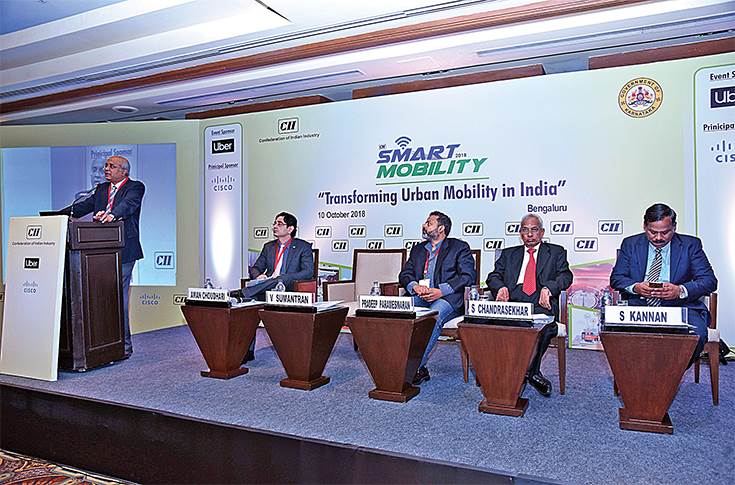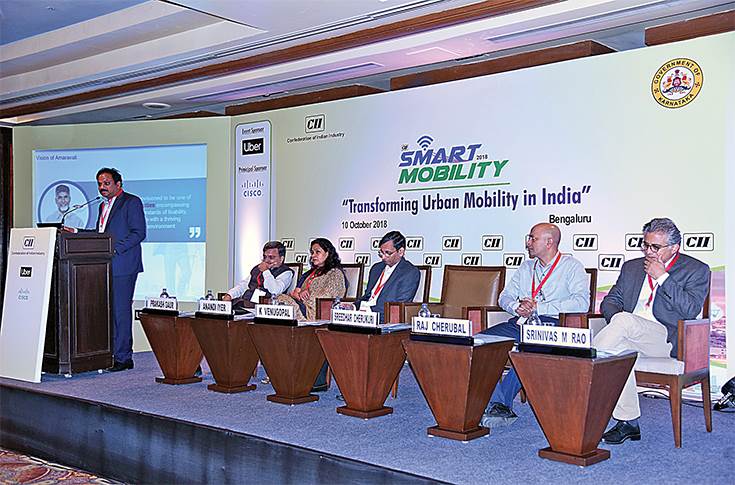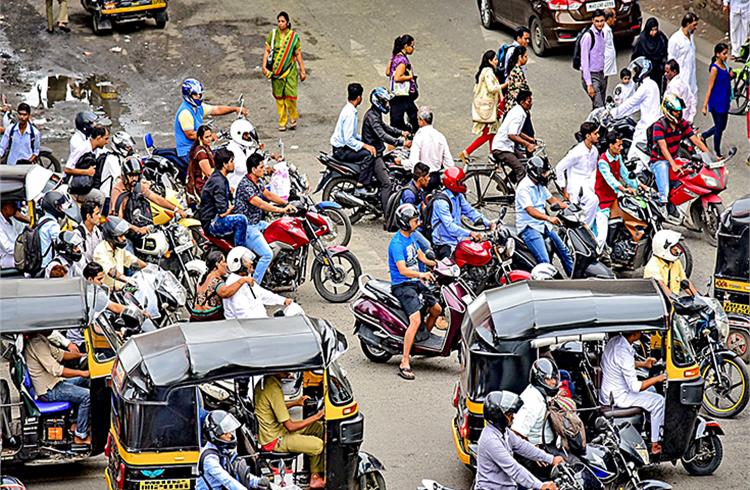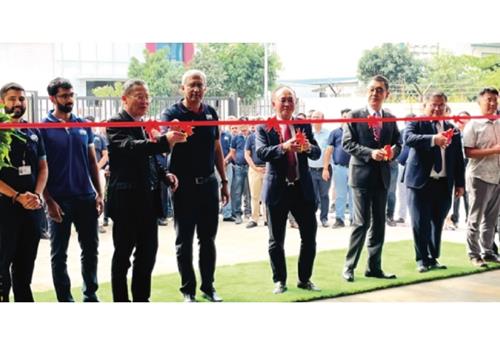India’s urban mobility landscape needs a fundamental shift
Industry heads met at a recent CII conference in Bangalore to debate and discuss the mobility solutions.
Like in some developed markets, India too is facing a crisis. The exponential growth in vehicle ownership and growing demand for transportation is leading to traffic congestions, lack of parking space, deteriorating life and inadequate infrastructure, particularly in cities. This is taking a heavy toll not only economically but also on human health, as is seen in the capital city with its poor quality of air. It all calls for a fundamental change in policies, which can benefit from emerging advanced technologies and newer business models.
To discuss, deliberate and find solutions to these vexing issues, the Confederation of Indian Industry (CII) organised the ‘Smart Mobility: Transforming Urban Mobility in India’ conference in Bangalore on October 10. The event brought together industry leaders and representatives of the government, academia and start-ups to actively debate the growing urbanisation, the need for seamless mobility solutions, the growing challenge of congestion and pollution and how India can show the the way forward.
Setting the tone for the day, Dr V Sumantran, chairman, CII Smart Mobility and chairman, Celeries Technologies, said: “Mobility is the lifeline of a nation which is visible in all the major nations’ economic developments over the past few decades. In post-war USA, there are direct co-relations between the rate of growth in the GDP and growth in mobility. Data clearly underscores that there is a symbiotic relationship between economic growth and mobility. As the economy gets vibrant, it demands a higher degree of mobility from people participating in the economy.”
“India is growing between 6-8 percent rates of GDP and to sustain this growth we have to pay attention to the mobility architecture that is embedded in each and every one of our cities. If this architecture starts to break down, our ability to sustain this economic growth can be jeopardised. Therefore, urban mobility is a critical focus area for India in the decades to come,” he said.
Speaking on urbanisation which directly co-relates to economic development and impacts mobility architecture, Dr Sumantran said, “We often say India is a rural economy but the pace with which the country is urbanising is staggering. It is expected that by 2050 we will be 53 percent urban, shifting our country’s landscape fundamentally. This means we have to deal with predominantly urban society with massive cities and congestion.”

Dr V Sumantran: "By 2050, India is likely to see 53 percent urbanisation. This means we have to deal with predominantly urban society with massive cities and congestion."
Pradeep Parameswaran, president, Uber India and South Asia, said mobility is one of the most difficult and urgent problems facing the planet today and how Uber is dealing with this bigger mobility crisis globally. “I firmly believe India has the opportunity to leapfrog private vehicle ownership as one of the core tenets for solving the mobility problem. India needs strong public transportation and all the stakeholders need to come together to solve the mobility crisis.”
He suggested three drivers to that mission: more people in fewer vehicles, which is ‘shared mobility’; non-fossil fuel vehicles using electric, ethanol and bio-fuel; and lastly encouraging use of the existing vehicle parc to transport people across cities than staying idle in parking lots.
City of future
In the first plenary session on ‘Envisioning a City of the Future’, the discussion revolved around urban development and planning, design, elements of a sustainable transportation system, mobility in global and Indian cities, government’s role and responsibilities of citizens in a modern city.
Dr Sreedhar Cherukuri, Commissioner, capital regional development authority office, Andhra Pradesh, detailed the concept, design and development of the new, modern capital city of Amaravati in Andhra Pradesh, which is being developed from scratch. “We are trying to make Amaravati as a happiness city with several pathbreaking initiatives through public-private- partnership, human-centric urban planning and design, with enough green space and water bodies. The city is highly responsive and completely sustainable; the physical well-being of the citizen is paramount in the designing of the city which will be fully digital and smart from day one, and focusing on economic development.”
“Amaravati is an urban innovative experiment that has never happened in this part of the world. Almost 40,000 farm families have joined hands with the state government in a true partnership by giving up their land – 35,000 acres – voluntarily for the construction of the capital city. The state is developing the city and giving back 45 percent of the developed part back to the farmers,” said Cherukuri.
Transformation of mobility
The world today is choking with a vehicle population of 85 million units. While new vehicle sales have slowed down in some developed markets, the aspiration of owning a car is still strong in the developing world, which means the demand for cars will continue to grow in emerging markets.
Speaking in the session titled, ‘Auto Industry- Transformation to address Future of Mobility, Shekar Vishwanathan, vice-chairman and director, Toyota Kirloskar Motors, said: “As we look towards 2050, the auto industry ought to realise that while it is contributing immensely to society it is also probably causing some hardship in the form of increasing pollution, reduced safety and high degree of wastage.”

Dr Sreedhar Cherukuri, Commissioner, Capital Regional Development Authority Office, Andhra Pradesh: "Amaravati is an urban innovative experiment that has never happened in this part of the world."
Sharing Toyota’s perspective, Vishwanathan said, “It is not technology A or B that is prescribed for all societal issues. What we need to address, which we at Toyota are trying to do, is that different customers have different needs and therefore, different technologies will address them including electric, hybrid, hydrogen vehicles and alternate fuels too. The auto sector is finding solutions customer-wise and looking for a range of technologies that can be adopted by the customer.”
Tarun Mehta, founder, Ather Energy, which has only recently begun selling its S340 electric scooter in select cities, remarked: “It is an exciting time in the automobile industry today; there are two sides of the equation with OEM at one end and the customer at the other. We see customer expectations are changing a lot and OEMs have to change a lot internally.”
Mehta said, “In India, the general perception about EVs is changing and customers are excited about them. If EVs are the future, OEMs need to change their thinking; an OEM’s job is no longer just as a vehicle manufacturer.
In the new world, the overall ownership experience is extremely important, this is true not only for EVs but across all vehicle segments. Customers are willing to pay a premium if OEMs improve their ownership experience. What’s important is not just design, manufacture and branding, but also data, infrastructure and value-added service.”
Revealing initial customer reactions to the Ather S340 e-scooter, Mehta said, “People across all ages are buying our scooter and also willing to pay a premium for the riding experience as they are rather excited about the features. We believe two-wheelers are going to be the first drivers of electric mobility in India. Although we are planning to introduce our scooter in 10 big cities in India, there is much excitement and response from smaller cities too.”
With more and more people migrating to cities for job opportunities, urban India is turning even more congested and motorists are increasingly spending more time on the road, thereby impacting the quality of life. And as there is no silver bullet to reduce urban challenges, all stakeholders need to work judiciously together to achieve real change.
Even though India will upgrade to BS VI emission norms around 17 months from now, research from developed markets indicates that despite having a large number of cars complying with advanced Euro 6 norms, still vehicular pollution accounts for over 50 percent of air pollutions. This means technology can help mitigate the problem but is not the entire solution.
(This article was first published in the November 1, 2018 issue of Autocar Professional)
RELATED ARTICLES
BRANDED CONTENT: Serving India’s EV ecosystem
Shimnit Integrated Solutions Pvt. Ltd. (SISPL), a subsidiary of Mumbai's leading high-security number plate supplier, Sh...
Driving EV business with agility and flexibility
CEOs from the EV startup ecosystem met in Bengaluru and Pune to discuss the challenges and business opportunities.
BRANDED CONTENT: SM Auto and Gotech energy inaugurate their first battery pack assembly plant in Pune
Pune-based SM Auto Engineering (SMA), a leading automotive component system manufacturer and its partner Gotech Energy (...





 16 Dec 2018
16 Dec 2018
 7274 Views
7274 Views





 Autocar Pro News Desk
Autocar Pro News Desk




